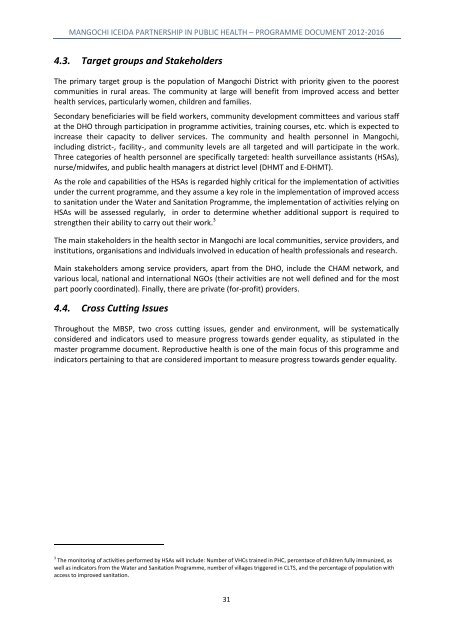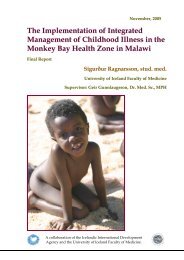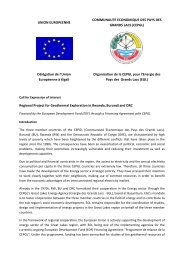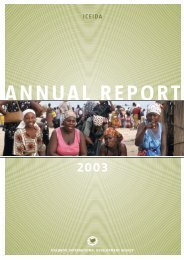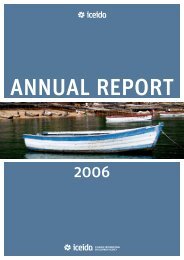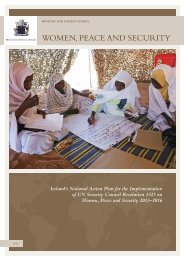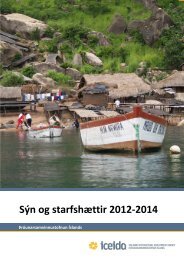Mangochi-ICEIDA-Partnership-in-Public-Health-2012-2016-Part-II ...
Mangochi-ICEIDA-Partnership-in-Public-Health-2012-2016-Part-II ...
Mangochi-ICEIDA-Partnership-in-Public-Health-2012-2016-Part-II ...
You also want an ePaper? Increase the reach of your titles
YUMPU automatically turns print PDFs into web optimized ePapers that Google loves.
MANGOCHI <strong>ICEIDA</strong> PARTNERSHIP IN PUBLIC HEALTH – PROGRAMME DOCUMENT <strong>2012</strong>-<strong>2016</strong><br />
4.3. Target groups and Stakeholders<br />
The primary target group is the population of <strong>Mangochi</strong> District with priority given to the poorest<br />
communities <strong>in</strong> rural areas. The community at large will benefit from improved access and better<br />
health services, particularly women, children and families.<br />
Secondary beneficiaries will be field workers, community development committees and various staff<br />
at the DHO through participation <strong>in</strong> programme activities, tra<strong>in</strong><strong>in</strong>g courses, etc. which is expected to<br />
<strong>in</strong>crease their capacity to deliver services. The community and health personnel <strong>in</strong> <strong>Mangochi</strong>,<br />
<strong>in</strong>clud<strong>in</strong>g district-, facility-, and community levels are all targeted and will participate <strong>in</strong> the work.<br />
Three categories of health personnel are specifically targeted: health surveillance assistants (HSAs),<br />
nurse/midwifes, and public health managers at district level (DHMT and E-DHMT).<br />
As the role and capabilities of the HSAs is regarded highly critical for the implementation of activities<br />
under the current programme, and they assume a key role <strong>in</strong> the implementation of improved access<br />
to sanitation under the Water and Sanitation Programme, the implementation of activities rely<strong>in</strong>g on<br />
HSAs will be assessed regularly, <strong>in</strong> order to determ<strong>in</strong>e whether additional support is required to<br />
strengthen their ability to carry out their work. 3<br />
The ma<strong>in</strong> stakeholders <strong>in</strong> the health sector <strong>in</strong> <strong>Mangochi</strong> are local communities, service providers, and<br />
<strong>in</strong>stitutions, organisations and <strong>in</strong>dividuals <strong>in</strong>volved <strong>in</strong> education of health professionals and research.<br />
Ma<strong>in</strong> stakeholders among service providers, apart from the DHO, <strong>in</strong>clude the CHAM network, and<br />
various local, national and <strong>in</strong>ternational NGOs (their activities are not well def<strong>in</strong>ed and for the most<br />
part poorly coord<strong>in</strong>ated). F<strong>in</strong>ally, there are private (for-profit) providers.<br />
4.4. Cross Cutt<strong>in</strong>g Issues<br />
Throughout the MBSP, two cross cutt<strong>in</strong>g issues, gender and environment, will be systematically<br />
considered and <strong>in</strong>dicators used to measure progress towards gender equality, as stipulated <strong>in</strong> the<br />
master programme document. Reproductive health is one of the ma<strong>in</strong> focus of this programme and<br />
<strong>in</strong>dicators perta<strong>in</strong><strong>in</strong>g to that are considered important to measure progress towards gender equality.<br />
3 The monitor<strong>in</strong>g of activities performed by HSAs will <strong>in</strong>clude: Number of VHCs tra<strong>in</strong>ed <strong>in</strong> PHC, percentace of children fully immunized, as<br />
well as <strong>in</strong>dicators from the Water and Sanitation Programme, number of villages triggered <strong>in</strong> CLTS, and the percentage of population with<br />
access to improved sanitation.<br />
31


